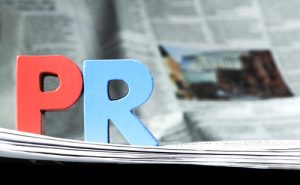Public Relations Career Guide – Jobs, Salary & Degree Info
Find your perfect college degree
In this article, we will be covering...

Choosing your career path is arguably one of the most critical decisions you’ll ever make in life. But there’s no saying how a job is without a solid understanding of and experience in it.
Who hasn’t heard about Public Relations? It’s everywhere. You’re probably considering a degree in Public Relations if you’ve clicked on this post. The work may appeal to you, but you’re not entirely sure if it’s the best fit for you.
We created this Public Relations Career Guide to help you determine whether or not this path is for you. This will describe the bits of Public Relations: the PR degree, the career paths you can pursue and the salary rates you can expect, the ways to advance your career, and the skills you need to become a success.
But before going into the specifics of public relations, let’s clarify: PR is not just about creating ideas for a commercial or creating fuss for press releases. It is more than giving away free stuff to gain customers’ favor.
It is a strategic communication process that builds mutually beneficial relationships between organizations and their public.
Whether you work for a PR firm on multiple accounts or represent an individual or a company, what you do is more than just raising brand awareness. You’re strategically establishing the client’s reputation, trust, and credibility.
What is Public Relations?
Public Relations comes in two categories: promoting a brand and defending it.
On the promotional side of public relations, professionals assist businesses or individuals in developing a positive public image through various unpaid or earned forms of communication, such as placements in traditional media, social media, and blogs.
On the defensive side of public relations, they assist their company or clients in maintaining and defending their public reputation during a crisis.
Public Relations is unique because it allows brands to connect with their target audience through credible channels such as trusted news outlets.
However, free publicity is difficult to come by. Because journalists must write stories that resonate with their audiences, public relations professionals must consider news outlets’ interests when developing their PR strategy.
Protecting a company’s or client’s reputation in the digital age is another challenge in public relations. Because humans have a negativity bias that helps us be more aware of threats, negative news naturally grabs and holds our attention better than positive news.
It also accelerates the spread of bad news on social media and Google, so it’s critical for public relations professionals to respond quickly to any adverse claims about their brand and mitigate the damage.
Traditional PR vs Digital PR
Consider traditional public relations as forms of communication that do not require the internet, such as radio, television, and print. Traditional public relations entails reaching out to these physical establishments and cultivating relationships. It necessitates the use of press releases, reputation management, and attendance at trade shows.
Because these avenues are easily identifiable, using traditional PR can be a great way to boost your credibility.
One of the most intense challenges of traditional public relations is that results are difficult to quantify. There’s no way of identifying how many people read your announcement in the newspaper.
Traditional public relations is more difficult to track. But, when it works, the rewards can be far greater than those of paid advertising and new media channels.
Digital public relations is similar to traditional forms of public relations in many ways, but it differs significantly in others. Building relationships and distributing press releases are still important aspects of digital public relations. The difference is that most of this networking and communication takes place online and via social media.
Building relationships with prominent bloggers and influencers is an essential aspect of digital PR. Influencers are well-known social media users with numerous followers and can reach tens of thousands to millions of people.
By establishing relationships with these people, digital PR reps can help create brand awareness while improving their clients’ reputation and SEO rankings.
While traditional public relations success is difficult to quantify, it is more accessible to track its success. Depending on the platform you will be using, digital PR reps can track metrics such as cost per click, engagement, cost per sale, and nearly any other type of metric you can think of.
On the other hand, you must be a bit more tech-savvy than the average consumer, which can be difficult for some.
So, which is better: digital or traditional public relations? The answer is not apparent.
To begin with, there is a reason why traditional public relations is, well, traditional. Although the world is becoming more digital, there is something to be said for good old-fashioned networking and relationship building. Furthermore, the general public continues to rely on traditional media outlets such as radio, television, and print.
Even those in the digital space frequently get their news and entertainment from “traditional” media sources. Hence, it would be foolish to pursue an entirely digital strategy while ignoring what has worked for so long.
Similarly, there is a reason why digital PR is gaining traction. Digital PR enables businesses and entrepreneurs to reach millions of potential customers at a low cost. Why waste time and money contacting newspapers or attending trade shows when you can get thousands to millions of people with the one click of a button?
Finally, neither digital nor traditional public relations is superior to the other. For maximum exposure, businesses use a combination of traditional and digital PR.
As with so many things in life, one must strike a balance between the old and the new, and it is the challenge of every Public Relations professional to determine where that balance lies.
Why You Should Pursue a Public Relations Career

Careers in Public Relations appeal to ambitious individuals who seek variety in their daily tasks and enjoy assisting others in leveraging and promoting their best qualities.
Those who excel in public relations typically have an open mind, sociability, a keen eye for detail, and the ability to thrive in stressful situations.
A PR Career Offers a Variety
In an ever-changing world, public relations professionals can stay challenged and relevant. Graduates can work in agencies, in-house at corporations, or as consultants or freelancers. There are also opportunities to specialize in one career path.
Graduates can pursue careers that combine their interests, such as RTWs or technology public relations. Specializing in a growing industry can help graduates differentiate themselves from the crowd. According to News & World Report, the third-best position in creative and media jobs is Public Relations Specialist.
PR is in High Demand
The Bureau of Labor Statistics predicts a 6% growth in PR employment opportunities between 2022 and 2032, though most applicants qualify for and seek entry-level positions.
Demand for PR professionals is driven by the need for businesses to maintain a positive public image in an increasingly community-oriented market. According to the BLS, specific skills, mainly social media skills, are preferred by employers.
A PR Degree Will Advance Your Career
Several public relations firms seek new hires with public relations degrees. While others may offer internships and entry-level positions to those without a degree, a PR degree can potentially increase new hires’ starting salaries and open the door to higher-level, more involved leadership opportunities within a firm.
PR Access Your Hidden Talents
Working in public relations allows people to socialize and build relationships. Those who enjoy interacting with diverse people and personalities will find this career ideal for maximizing their abilities. Finding effective ways to connect with others is a distinct and valuable skill.
Many public relations professionals are gifted writers with solid storytelling and communication skills. This is very useful because connecting both in-person and online is an essential aspect of a PR career in today’s market, which means that digital natives who embrace social media can benefit from learning how to use Facebook, Instagram, LinkedIn, and other platforms such as part of PR strategies and campaigns.
With the emergence of social infrastructures such as Twitter, Facebook, LinkedIn, and Pinterest, combined with the versatility of Web tools, jobs for public relations specialists are growing at a rapid clip.
PR Open Doors to Industry’s Biggest Events
Public relations professionals attend special events to network with key individuals, report on publicized events, and stay updated on the latest information.
At these events, people who enjoy traveling, learning valuable information, and speaking with top professionals in a fast-paced lifestyle can get the inside scoop on the latest happenings while developing excellent business relationships.
PR professionals are among the first to learn about new developments, upcoming releases, product innovations, and other developments while expanding their network.

What are the Career Options for a Public Relations Degree?
You possess the necessary skills and enthusiasm for a career in public relations. You’ve streamlined your skills. You have the necessary contacts. You will be well-prepared for any of the following occupations:
- Media Relations
- Marketing Communication
- Freelance Writer
- Strategic Planner
- Multicultural Relations
- Government Affairs
- Sales Representative
- Account Executive
- Public Information Officer
- Employee Relations
- Production Coordinator
- Media Planner
- Special Events Coordinator
- Researcher
- Marketing Coordinator
- Copywriter
- Fundraiser
- Direct Marketing Spokesperson
- Media Buyer
- Investor Relations
- Counselor
- Marketing Manager
- Art Director
You can also use your PR degree to become a:
- Broadcast Journalist
- Charity Fundraiser
- Personal Assistant
- Policy Officer
- Politician’s Assistant
- PPC Specialist
Public Relations Degrees: Concentrations
Political Communication
A concentration in political communication prepares students for communications-related roles in the public sector.
Speechwriting, public speaking, and campaigning classes teach students how to support candidates and politicians. They also learn how to apply basic communication and reputation management principles to government work.
Advertising
Advertising is critical in reputation management and shaping a company’s public image. Students in this concentration learn about the creation of advertisements and the role that advertising plays in marketing campaigns and strategies. Students examine successful advertising campaigns and case studies.
Digital Media
This concentration teaches students how to use online publications, social media, and other forms of digital media effectively.
Courses cover topics such as web design, visual storytelling, and multimedia journalism. Students learn how new media formats alter the landscapes of entertainment, news, and public relations.
Corporate Communication
Students in this concentration learn how to manage a large company’s internal or external communications.
Courses in media relations, international communication, and investor relations teach students to communicate with stakeholders effectively. This concentration is frequently used to provide an overview of corporate responsibility, identity, and branding.
Project Management
Students majoring in public relations who focus on project management learn how to lead teams and manage campaigns. Organization, planning, scheduling, and quality assurance techniques are covered in the coursework.
Students are also taught how to create and manage budgets, negotiate with vendors, and set long-term goals.
Public Relations Degrees: The 4 Available Models
Traditional Publicity Model

PR professionals use the traditional publicity model to generate media coverage for clients, products, or events. These efforts can range from outrageous publicity stunts to straightforward news conferences to celebrity interviews in fashion magazines.
P. T. Barnum was an early American practitioner of this type of public relations. His outrageous publicity stunts were successful because he was unconcerned about receiving negative press; instead, he saw any coverage as valuable.
Musicians who court controversies, such as Lady Gaga and Marilyn Manson, are recent examples of this style of extreme publicity. The modern phenomenon of faded celebrities on TV shows, such as Paula Abdul’s long-running appearances on American Idol, is a more restrained example of this type of PR.
Public Information Model
The public information model’s goal is to disseminate information to a constituency. This model is concerned with sharing information in a way that ensures adequate reception rather than obtaining dramatic, extensive media coverage.
Utility companies, for example, include energy efficiency fliers with customers’ bills, and government agencies such as the IRS issue press releases to explain to the public the changes to existing codes. Furthermore, public interest groups disseminate the findings of research studies to policymakers and the general public.
Persuasive Communication: Two-Way Asymmetric
The two-way asymmetric persuasive communication model persuades a specific audience to adopt a particular behavior or point of view. This PR model requires a measured response from its intended audience to be considered adequate.
An excellent example of this model is government propaganda. Propaganda is the organized dissemination of information to aid or weaken a cause. Edward Bernays has been dubbed the “Father of Modern Public Relations” for promoting the sale of war bonds during World War I.
One of the first professional public relations experts, Bernays made the two-way asymmetric model his early trademark. He persuaded a group of well-known celebrities to walk in the New York Easter parade while smoking Lucky Strike cigarettes in a famous campaign for Lucky Strike cigarettes.
The majority of modern corporations use the persuasive communication model.
Two-Way Symmetric Model
The actual communication between the parties involved is required in the two-way symmetric model. This PR model is frequently used in town hall meetings and other public forums where the public has a tangible impact on the results by facilitating a back-and-forth discussion.
It often results in mutual understanding and an agreement that respects the wishes of both parties.
Congressional representatives strictly follow this model in an ideal republic. This PR model is used by many nonprofit organizations run by boards and has public service mandates to ensure ongoing public support.
This model is also used in commercial ventures. Public relations can garner media attention or attract customers and facilitate communication between a company and its investors, partners, and employees.
The two-way symmetric model is useful in internal communication because it makes employees feel essential to the company. This model is also frequently used in investor relations.

Public Relations: Your Career Path (Careers in PR)
The public relations industry encompasses a wide range of job opportunities in various industries and at various experience levels. Before you begin your degree or job search, consider the following career paths and see which fits you the best.
Public Relations Manager
Public relations managers look after their client’s public image and reputation. Many people who enter this field have formal training and experience, but some advance to management positions through lower-level public relations positions.
To maintain their client’s public image, these individuals must write and review information or press releases for the media and designate a spokesperson or provide any additional required information. They usually do this through advertising.
They also assist their clients in communicating with the general public and determining the best way to reach their target audience. These professionals must also supervise the activities of their employees. Other duties and responsibilities may include:
- Figuring out how to reach target audiences
- Identifying social trends
- Creating an image to respond to trends
- Overseeing internal communications
- Supervising staff
The Bureau of Labor Statistics specifies that Public Relations managers earn a median of $125,620 per year. The BLS also reported a 6%, or faster-than-average job growth forecast for these professionals from 2022 to 2032.
Public Relations Specialist
A PR specialist is the most obvious career path for someone with a degree in public relations. These professionals are in charge of maintaining and controlling a positive image for their employers or clients. This is usually a company or other organization, but it can also be a single person.
Public relations specialists, also known as communications specialists and media specialists, are in charge of an organization’s communication with the general public, including consumers, investors, reporters, and other media specialists.
Public relations specialists in government may be referred to as press secretaries. Workers in this setting keep the public up to date on the activities of government officials and agencies.
Public relations professionals write press releases and contact media members who may print or broadcast their material. Many radio and television special reports, newspaper stories, and magazine articles begin on the desks of public relations professionals.
A press release, for example, might describe a public issue, such as health, energy, or the environment, and what an organization is doing about it.
In addition to traditional media outlets, press releases are increasingly distributed via the Internet and social media. Public relations professionals are frequently in charge of monitoring and responding to questions and concerns raised on social media.
Public relations specialists differ from advertisers because they obtain media coverage for their stories rather than buying ad space in publications and on TV.
In general, the job responsibilities of a public relations specialist are as follows:
- Prepare press releases and information for the media.
- Respond to media inquiries for information.
- Assist clients in effectively communicating with the general public.
- Assist in the preservation of their organization’s corporate image and identity.
- Prepare speeches and set up interviews for a company’s top executives.
- Examine advertising and promotion programs to see if they are compatible with their organization’s public relations efforts.
- Utilize social media to gauge public opinion about clients.
The median annual salary for public relations specialists today is $67,440. Their job growth forecast is 6% from 2022 to 2032, faster than the national average.
Marketing Executives
A person with a background in public relations can easily transition into marketing. To keep companies on brand, public relations professionals work closely with marketing departments.
Marketing executives are in charge of contributing and developing integrated marketing campaigns to promote a product, service, or idea. This is a multifaceted role that entails the following:
- planning
- advertising
- public relations
- event organization
- product development
- distribution
- sponsorship
- research.
Because many organizations have marketing departments, one can work in public and private industries ranging from retail, finance, and media to voluntary and charitable organizations.
The nature of this role will vary depending on the size of the organization and sector. It will also vary on the focus, whether selling a product or service or raising public awareness of an issue.
The median annual salary for marketing executives or marketing managers is $138,730. The overall employment of marketing executives is expected to grow 6% from 2022 to 2032, above average for all occupations.
Event Manager
Because of their attention to detail and training in dealing effectively with the public, people trained in public relations make good event planners. Businesses or organizations organize many events to draw attention to themselves.
Events play a significant role in the success of a brand or organization. Event managers organize conferences, seminars, and exhibitions, as well as parties and corporate incentive trips. They manage various events, ensuring that the target audience is engaged and that the event’s message is promoted correctly.
Event Managers oversee the planning, run the event, and complete the post-event evaluation. The position is primarily hands-on and frequently requires working as part of a team.
As an event manager, you’ll need to:
- Investigate new client and event opportunities.
- Liaise with clients to determine their specific event requirements
- Create detailed event proposals (including timelines, venues, legal obligations, suppliers, staffing, and budgets).
- Look into venues, suppliers, and contractors before negotiating prices and hiring.
- Manage and coordinate all event logistics and suppliers.
- To publicize and promote the event, collaborate with the sales and marketing teams.
- Manage all pre-event planning, including the organization of guest speakers and delegate packs.
- On the day of the event, coordinate suppliers, handle client inquiries, and troubleshoot to ensure that everything runs smoothly and within budget.
- Manage a team of employees, providing detailed briefings.
- Organize parking, traffic control, security, first aid, hospitality, and media facilities.
- Ensure that all insurance, legal, health, and safety obligations are met.
- Oversee the event’s dismantling and removal and efficiently clear the venue.
- Create a post-event evaluation to help guide future events
The BLS predicts an 8% job growth for event managers, including event management professionals, between 2022 and 2032. The median annual salary of event managers was $52,560 in 2022.
However, you should note that event managers must start a career as event planners to understand every inch of the industry.
Nonprofit Executive Director
The Nonprofit Executive Director wears many hats, and to be effective, this person must wear them all equally well.
In essence, this highly regarded position supervises other leaders at an organization, works directly with the board of directors, and ultimately shapes the organization’s future by steering your team in the right direction. However, those with a doctorate are frequently considered for this position.
Nonprofit executive directors bear enormous responsibility, leaving no room for error. Instead, your team must go above and beyond to fully comprehend the executive director’s authority and do everything possible to support their work.
Executive Director Responsibilities:
- Revenue and expenditure reporting
- Participating in community groups.
- Developing solid business plans
- Creating and implementing organizational strategy.
- Making policies and philosophies for the organization.
- Supervising day-to-day business operations.
- Conducting performance appraisals
- Preparing detailed budgets.
- Department heads are being mentored.
- Keeping track of financial accounts.
The average US salary for a Nonprofit Executive Director is $73,627, with a salary range of $39,000 to $130,000.

Social Media Manager
The increased digital exposure for businesses, particularly when managing social media channels, has primarily driven the need for more public relations professionals.
As companies seek to engage their customers through these digital channels, the demand for social media specialists is increasing. Public relations students have classes about social media and how to manage a company’s image, and this is why many PR students choose this career path.
A social media manager manages an organization’s online presence by creating a strategy, analyzing usage data, facilitating customer service, creating quality content, and managing projects and campaigns.
Social media management, also known as social media coordination, can play a distinct role in larger organizations. The role may be combined with other marketing and communications responsibilities in small and medium-sized businesses. The term “social media account manager” is frequently used in advertising agencies.
The Social Media Manager’s job is to increase brand awareness through the effective use of social media outlets. Here are the tasks assigned to a social media manager:
- Create and maintain the company’s brand through the use of social media marketing tools.
- Create social media marketing campaigns with marketing professionals.
- Use the company’s social media accounts to interact with customers and other stakeholders.
- Analyze the company’s digital marketing strategy and social media strategy, identify strategic flaws, and make recommendations for improvement.
- Investigate social media trends and inform management of changes that affect the company’s marketing efforts.
- Set key performance indicators (KPIs) for social media campaigns, such as a target number of shares or likes, and measure campaign performance against the KPIs.
The Bureau of Labor Statistics (BLS) hasn’t explicitly tracked the job outlook for social media managers. It does, however, track the growth of advertising and marketing managers, which indicates the industry’s overall growth.
According to the BLS, marketing jobs are expected to grow by 6% from 2022 to 2032, faster than average. The median annual salary was $138,730 for social media managers in 2022.
Writer
Students in public relations are taught how to write well, and much of their communication with the public is done through writing, such as press releases and social media posts. As a result, becoming a writer is relatively simple for someone with a background in public relations.
Copywriters, in particular, assist businesses in developing their brands, creating online content, and reaching out to both existing and new customers. Technical writers, digital content writers, book writers, and writers specializing in other subjects can all find work if they have strong writing skills.
Writing for any organization entails several duties and responsibilities. Some of the tasks that a writer may be expected to complete are as follows:
- Conduct research on the topics assigned to them.
- Check the accuracy of any data gathered during the research process.
- Create content in the form of articles, blogs, or papers based on the research data.
- Create well-researched pitches and send them to an Editor for approval.
- Read style guides or project briefs and apply what you’ve learned to create content for assignments.
- Convert the information they’ve gathered into readable, user-friendly content tailored to their target audience.
- Revise their work in response to editorial feedback.
According to the BLS, the median annual salary for technical writers is $79,960. From 2022 to 2032, the job growth outlook is 7 percent faster than the national average.
Marketing Coordinator
In large public relations firms, developing an organization’s brand image is a must. This work often involves working closely with the marketing department to plan and execute marketing campaigns and promote the organization as a whole.
Marketing coordinators ensure the efficient process of achieving this. They are responsible for assisting with media coverage, press releases, and client relations.
While their job may often overlap with that of the public relations specialist, marketing coordinators often focus on the marketing side of things. They should be able to help in creating a solid online presence for the organization.
This includes implementing SEO strategies together with the digital marketing executives that will help the organization’s relevant pages rank in Google. They are integral in assisting with the development of content and email marketing strategies for customers and registered users.
They will often liaise with the marketing team and the clients to plan strategies and implement them effectively. Good communication skills and solution-based aptitude are needed to manage brands and maintain good relationships with clients. Other responsibilities include:
- Analyzing outcomes of public relations marketing campaigns and reporting the findings to management.
- Overseeing the creation of content and materials for marketing.
- Enhance branding initiatives with the help of the marketing department.
On average, a marketing coordinator can earn a base pay of $57,000 a year.
Art Director
Art directors play an important role in the field of advertising and public relations. They are primarily responsible for executing the message that clients want to get across and conveying them to target customers.
They take care of the visual aspects of the advertising campaign, often coordinating with the design team, like the graphic designers, video editors, and website designers, among others.
Depending on what media the client prefers, art directors will oversee the process of visual styling and imagery. It is important that they communicate the message visually in a way that is understood by the audience.
Their work with the design team will include creating images like illustrations and graphics, taking photographs and videos, designing the stage and sets, and creating visual aids like charts and graphs.
Many art directors develop the visual concept with the client’s preferences and determine the design elements that will go with it. The work will often involve brainstorming a concept or idea and presenting it to the client and the marketing team.
As an art director, one must have a keen eye for artistic details and a great imagination to bring concepts to life. It is also important for art directors to be organized and adaptable to any given situation.
Other responsibilities expected from art directors include:
- Develop the overall look of the campaign.
- Supervise the design team and make sure they meet the set goals and expectations.
- Review and approve the artwork, photography, graphics, and other design elements produced by the design team.
- Meet with clients to establish the artistic approach and style.
- Create a detailed budget and timeline for the design elements.
Art directors may receive a median pay of $105,180 per year, according to BLS.
Public Affairs Consultant
Another career path for those who are in the field of public relations is assuming the role of public affairs consultant. This profession involves helping push the agenda to lawmakers or rally the support of the public over competing options.
A Public Affairs Consultant will be responsible for creating public information campaigns that push for reform or advance a certain agenda.
Public consultants often work with agencies or private employers with a vested interest in specific issues. They may need to push the agenda of their clients and restore public confidence. They have to be careful in responding to issues as it might be quite challenging to repair the damage if issues are not handled properly.
While the job might have a negative connotation to an average consumer, public affairs consultants are valuable in the way of educating, informing, and persuading lawmakers.
Public affairs consultants must be knowledgeable in government affairs and the inner workings of the lawmaking system. They must study the latest news and developments in the country and beyond, ensuring to pay closer to issues relevant to their cause.
Other initiatives public affairs consultants are expected to take part in include:
- Managing and implementing strategies to support public affairs issues.
- Supporting policy programs and presentations relevant to the cause they are advancing.
- Monitoring and assessing various regulatory and legislative developments.
- Developing messages and communication tactics to promote advocacy initiatives.
- Identifying and solving problems effectively.
On average, public affairs consultants can earn a median pay of $71,954 per year. This can, however, vary depending on one’s education, certifications, and other important factors.

How to Start Your Career in Public Relations
Associate Degree in Public Relations
Holders of an associate degree in public relations can pursue entry-level positions in various industries, including advertising and marketing.
Graduates interested in strategic or legal communications can work as paralegals, while those interested in marketing or advertising can work as advertising sales agents.
An associate degree in public relations will also prepare graduates to transfer into a bachelor’s degree program in public relations.
Bachelor’s Degree
The next step is to obtain a bachelor’s degree in a relevant field. While a degree in public relations may seem like the obvious choice, according to the Bureau of Labor Statistics (BLS), communications, journalism, and marketing degrees are also viable options.
Degrees specific to the field may also be appropriate for some industries. Coursework in public relations may include:
- Media Writing
- Communications
- Public relations theory
- Research methods
- Public relations internship
Master’s Degree in Public Relations
Professionals with a master’s degree in public relations can pursue leadership positions such as public relations manager, advertising manager, and marketing manager. They may also hold positions such as director or vice president.
Graduate students can further specialize their training during a master’s program by pursuing a concentration. Prospective students can learn more about the best online master’s programs in public relations.
Doctorate Degree in Public Relations
A Ph.D. in public relations prepares graduates for the most senior positions in the field, including academic titles such as professor and academic dean. Doctoral students complete coursework that provides advanced public relations knowledge and training within a specialization during their Ph.D. program.
How to Advance Your Career in Public Relations
Develop Work Experience
Due to the high level of competition for entry-level positions in public relations, students may seek internships during or after completing a bachelor’s degree program to gain training and experience.
Journalism is another industry that offers opportunities for advancement leading to public relations positions; familiarity with media practices can be highly beneficial to those guiding and safeguarding their companies’ public image.
For entry-level employees, larger companies may provide extensive on-the-job training. The first few years in the industry are typically spent mentoring and training. Because of the nature of the work, essential characteristics for a career in public relations include good judgment, initiative, and creative problem-solving skills.
Train for Management
There are numerous training opportunities available to public relations specialists who want to advance to positions in public relations management. Employees in specialist positions are frequently chosen for management training and advancement.
Some large corporations provide in-house management training, while others offer employees continuing education coursework or programs. Professional associations may also offer training seminars for aspiring public relations managers.
After you earn your degree and find a job where you can gain experience, the process of working your way up to a public relations management position begins. Earn a voluntary certification to boost your business reputation, and then look for management training programs to help you move up the ladder.
Earn Certification
Voluntary accreditation is one step toward establishing a professional reputation as a public relations specialist. Two different professional organizations provide such accreditation.
The Universal Accreditation Board offers the Accredited in Public Relations (APR) designation. This certification is intended for public relations professionals with five years of experience and bachelor’s degrees in communications or related fields. Applicants who pass a computer-based test are eligible for the APR.
Qualified applicants can obtain the Accredited Business Communicator (ABC) certification from the International Association of Business Communicators. This certification program is intended for general business communicators.
ABC certification requires both written and oral tests, in addition to nine years of combined education and work experience.

Skills Needed For a Career in Public Relations
Since there are several job offers in the public relations industry, skills will vary. However, in general, positions in public relations necessitate excellent communication, interpersonal, problem-solving, organizational, speaking, and writing skills.
Communication
A publicist must create compelling content for clients, such as press releases, magazine articles, and blog posts. Content must appear in venues and pages (traditional and digital) that the client does not own.
The content must appeal to the reader and the prospective publisher—the editor of the magazine or newspaper who will decide whether or not to publish the piece.
The goal of website content and blog posts is to read, engage with, and share within their virtual network at a rapid pace. The text must not only convey the client’s message compellingly and engagingly, but it must also serve the publisher’s needs. Writing must be technically perfect, but the message and content must also be relevant and exciting.
- Presentation
- Promotion
- Press Releases
- Editing
- Editorial Opinions
- Journalism
- Logical Thinking
- Active Listening
- Content Writing
- Written Communication
- Writing Blog Posts
- Website Copy
- Verbal Communication
- Speech Writing
- Media Outreach
- Media Relations
- Public Speaking
- Video
Social Media
Public relations professionals must be familiar with all forms of social media currently in use—a list that is constantly changing.
Because social media platforms differ significantly in how they operate and to whom they may appeal, each platform necessitates a unique strategy.
Some messages simply lend themselves better to certain platforms than others. A good public relations director knows which platform to use for what and how to use each platform to its full potential.
- Social Media Groups
- Virtual Communities
- Social Media Analysis
- Social Media Releases (SMRs)
- Scheduled Posting
- Content Marketing
- Content Management Systems (CMS)
- Digital Marketing
- TikTok
- Medium
- Snapchat
- YouTube
Research
Public relations professionals work with a wide range of clients in a variety of fields. To provide excellent service to each client, the practitioner must quickly become “up to speed” with the brand, market, and industry of the client.
- Primary Sources
- Secondary Sources
- Search Engine Research
- Library Research
- Interview Research
- Research Organization
- Deductive Reasoning
- Inductive Reasoning
International Perspective
To be a successful PR person, you need to understand this: Not all people think the same way as you do. You could like a particular political party, but others may not.
Even when it comes to food, what others think is delicious could be a big no to some. By accepting this fact, you will start developing an international, multicultural perspective.
A message that works well for one group of people may alienate another. A good public relations professional understands and anticipates these differences and can conduct research or enlist the assistance of others as needed. Fluency in multiple languages is an advantage.
- Market Research
- Audience Segmentation
- Emotional Intelligence
- Diversity
- Collaboration
- Multilingual
Time Management
Public relations professionals must manage multiple clients and projects simultaneously, all of whom expect to be treated as essential and require their work to be completed as soon as possible. Understanding deadlines and prioritizing tasks is crucial.
A physical organization is also required. It’s a fast-paced, multifaceted job where no one has time to misplace paperwork or mix up names.
- Scheduling
- Prioritizing
- Multitasking
- Attention to Detail
- Project Management

Creative Thinking
To capture attention in a splintering market, publicists must be bold and creative. That doesn’t mean breaking the rules; it often means finding the loopholes! Ultimately, it means knowing when to take risks and thinking creatively.
- Problem-Solving
- Collaboration
- Tact
- Bearing
- Proactive
- Stress Tolerance
- Bold
- Troubleshooting
- Brainstorming
Coordination
To succeed in the field of public relations, one must employ good coordinating skills as one plan and execute campaigns. This skill will ensure the tasks are manageable and can be accomplished.
One needs to be capable of paying close attention to details while considering how each one will fit into a larger project. This will mean being able to plan work schedules, execute strategies, and oversee the whole project until it is completed.
- Planning
- Attention to detail
- Flexibility
- Organization
- Teamwork
Strategic Thinking
As public relations specialists, one must be able to think on their feet. Their work often involves meeting journalists and media buyers face-to-face, so being able to employ quick strategic thinking skills will allow them to make a pitch and execute their campaigns successfully.
Planning publicity strategies and campaigns.
- Thirst for learning
- Taking constructive criticisms
- Innovate
- Proactive
- Adaptability
Additional Information:




